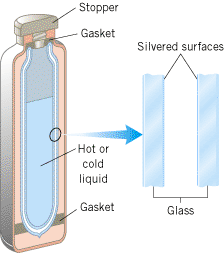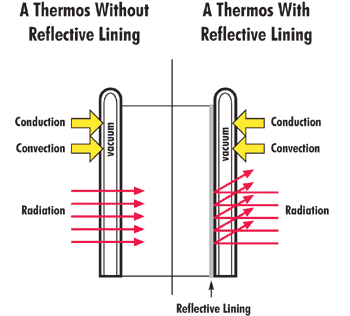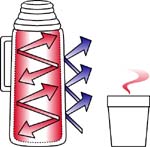The Thermos: Minimizing Conduction, Convection, and Radiation
 The Scottish chemist and physicist Sir James Dewar invented the Thermos flask, also known as the Dewar flask or vacuum flask, in the 1890's for the purpose of storing liquid gases at very low temperatures. The basic function of the vacuum flask is to thermally insulate the contents and prevent heat flowing either in or out.
The Scottish chemist and physicist Sir James Dewar invented the Thermos flask, also known as the Dewar flask or vacuum flask, in the 1890's for the purpose of storing liquid gases at very low temperatures. The basic function of the vacuum flask is to thermally insulate the contents and prevent heat flowing either in or out.
A Thermos blocks the movement of heat to and from the substance by minimizing conduction, convection, and radiation.
The substance to be kept hot or cold is kept inside a container with two glass walls that are separated by a vacuum. The movement of heat by both conduction and convection requires matter: if you have a vacuum, you can’t have any conduction or convection of heat!
Conduction takes place only between the substance and the cap, which is generally made of a non-conductive material, and is small so that contact with the substance is minimized.
Convection is entirely minimized because the substance cannot flow into or out of the container.
In our illustration, radiation is reduced to a minimum by silvering the glass, generally on the two internal faces, so that the radiant heat waves are reflected. This usually blocks up to 97% of the radiation and therefore, a significant part of the total heat transfer.

Different types of insulation products reduce the heat transferred by conduction, convection and radiation to varying degrees. As a result, each provides different thermal performance and corresponding  "R" values.
"R" values.